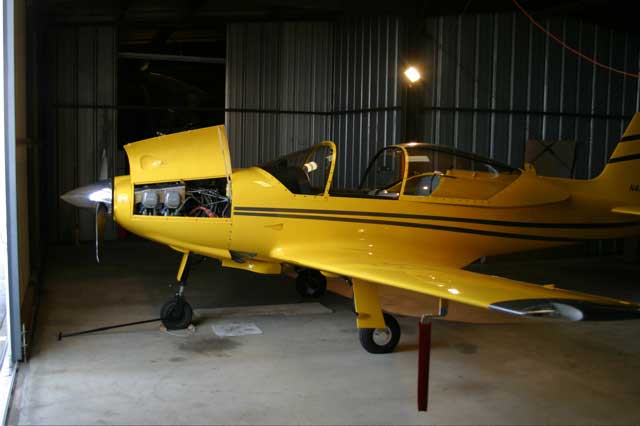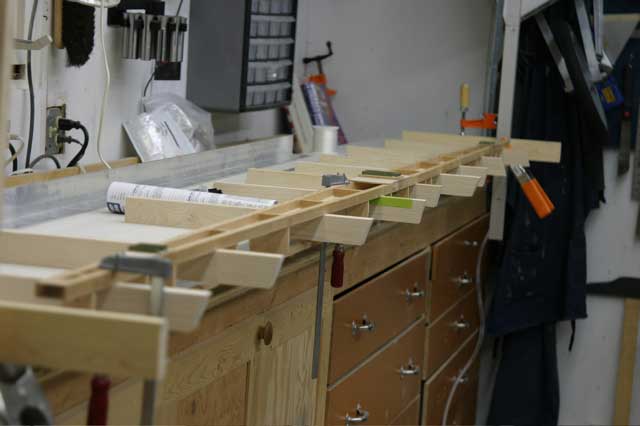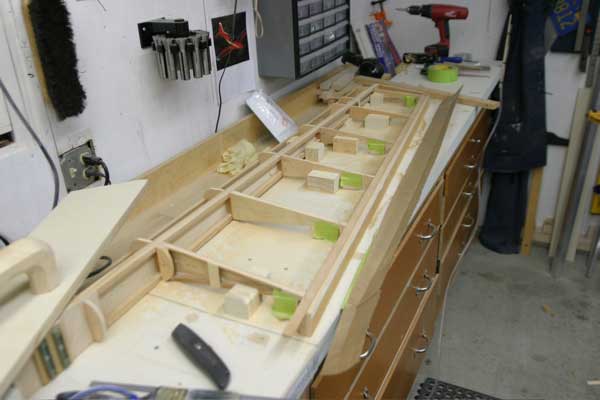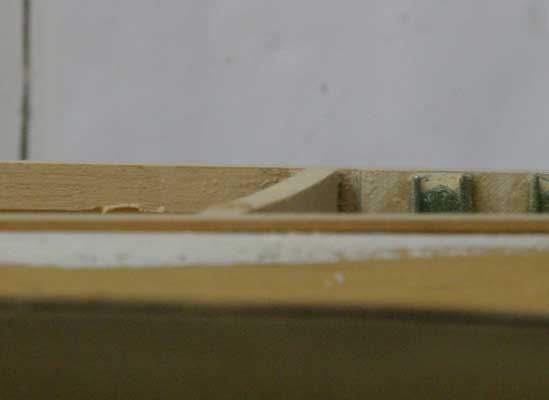John Kahrs
![]()
John Kahrs |
|
Henson's Falco
I went down to Livermore to take a look at Doug Henson's yellow Falco. It's pretty fresh. I saw him a year or two ago and it was upside down, a mess of landing gear and firewall forward stuff filling his garage. I never thought I'd see it done so fast. I visited Dan Dorr's plane a few years ago too, He's flying now. Since I've bought those tail kits, other guys had built complete airplanes. Doug was very nice, answering all my tedious questions, confirming some things, debunking others. I can say for sure that unless the seat tracks can be changed dramatically, I'll never fit in the Nustrini Canopy, even the raised Nustrini, which is what Doug has. That's fine. I like a classic. Otherwise, he's built exactly the plane I want: full gear doors, inverted header tank, IO360 engine, and the panel is perfectly updated with a Garmin GPS and autpilot that will fly IRF approaches. Livermore was pretty foggy. I didn't ask him for a ride, which was fine. I just wanted to know if that canopy was going to work.

I went back to the garage, fixed some stuff around the house, then doubled the number of leveling blocks for the elevator construction. Bought a straight edge at Home Depot (it's good enough, just extruded L angle stock). Came back and glued a stringer on the elevator leading edge. Then I took a couple hours cutting all the plywood skins for the tail section. Incredibly tedious, especially after seeing a complete airplane, it's hard to think about cruising at 170kts down to Santa Monica while doing something like that.
But I am pretty confident that I could be skinning the elevator in a week.
Haunted by levels
I put together a 16 foot long workbench a couple years ago anticipating that I'd use it to build the tail and ailerons for the Falco. It's horribly not level, so I epoxied a series of riser blocks on it and took a shot at leveling that. Not good enough, I decided. Today I brought home a solid core door from Home Depot, ripped it down the middle and butted the ends together with a biscuit joiner. After checking along the length of it with a water level, I shimmed the blocks and screwed the door slabs down on it. The water level is just clear tubing, but it's infuriatingly accurate. It's easy to see if one side is a millimeter, or even half a mil high or low across a 16 ft span. I got pretty anal about it tonight. I leveled it across the other axis as well, using something called a SmartTool digital level, which gets me to 1/10 of a degree.

I epoxied maple extensions to hang the elevator spar from, and of course the spar is slightly twisted along its length. I considered letting the spar just be what it wants to be, and allowing it to twist invisibly inside the structure of the tail, but I'm going to straighten it as a I assemble. I'm confident the hinges will still align properly.
Each day I work on it, I wonder when enough is enough. I have real doubts about my accuracy. I wonder if I jus think 'm right, and something I can't see is wrong. Or maybe my methods are flawed, I just don't know it, and the twisted Falco I end up with will be covered with trim tabs.
As it is, I have no guru, no seasoned builder to guide me. I have memories of my dad drawing layouts with a wood spline on our kitchen floor for an 18' racing sloop when I was about 10. I watched him build boats and houses quite a bit, and my affinity for woodworking and respect for tools, especially the table saw, I owe to him. I have only sporadic visits to Falco builders, never remembering the questions I wanted to ask. I just stand there gawking "Gosh mister, it sure is purdy." I have Alfred's manual, which is excellent, and I have my own conscience pushing me to reject results that aren't good enough. I don't even know who to invite over. Engineers? Machinists? EAA guys?
I read some later chapters in the manual this past weekend, and it gets worse- like drilling holes and slots in the main wing spar. Alfred Scott tries to keep it light, but it was so daunting and exhausting I just had to close it after a while. The scope of building this plane is withering to me right now as I glue my feeble little ribs to my little elevator. Putting up the wing jig will make these ramblings sound ridiculous. The idea of gluing that one fuselage frame to the main spar was terrifying. Is that all that holds the damn thing together? A cup full of Aerolite that I stir I one evening months from now?
I was at Harbor Freight this weekend getting cheap tools, and I considered buying a cross slide vise for the drill press so I could cut those slots in the spar. It was so cheap and awful I decided against it, but I would still like to mill those slots with precision.
Elevator, Part III
I am a hack. Sometimes I go in the shop and I know what I'm doing is a mistake. I know I've probably sanding too much of a part away. I should just get out of there when I feel that way. On one hand, I'm trying to keep the momentum going, but that can end up degenerating into simply rushing the job. I've had to make a couple of ribs over again because of this. Luckily they weren't complex ribs- just solid triangle of spruce, but it probably cost me an evening right there.
The trailng edge is installed on one side of the elevator. The trim tab is built up, and the other trailing edge will go on tonight as I continue wrestling with the tip bows.
The wing ribs came, along with the wing equipment. There must be four thousand staples in those ribs, and I'm still pretty sure I want every last one of them gone. It's going to a long week of plucking those suckers out with a steel pick.
Out of the jig
The elevator is out of the jig. There are so many small errors in it. So many things I only understand now that it's done. The idea of starting with the tailplane is a fine idea - it's a small part of the plane that I hope folks wont be looking at first, and it incorporates a good many of the techniques used in building the rest of the airframe. I'm not saying it's unimprortant, in fact it's probably the last thing I'd want to fail in flight, but a little wobble in its waxed reflections can be more easily forgiven than in the ailerons or wing. At least by me.
Or not. I sometimes wonder if I should build it again properly. It's fairly straight, but I could see myself making a much more refined version if I did it again. I'm daunted enough by the upcoming steps of float sanding and skinning it that I decided to build a miniature version of it to practice on. I made three ribs and a half a spar out of pine, shrunk laterally so it's only about a foot and a half long. I'll try to sand it, skin it, fiberglass it and take it to final paint just to see what it will take to make this plane look like it should.
Float sanding, purported to be one of the most tedious parts of building a Falco, is when you take a big flat board with sandpaper stuck to it and pass over the naked framework diagonally until there are no high or low spots. It's interesting to me that on the Falco website there's no mention of supporting the delicate framework of these tailplanes while you mash into it and skew it with pressure of sanding. The thing is so fragile, and you have to apply force against it in the weakest directions. I epoxied blocks around all the ribs so they won't wiggle and hopefully won't snap off, and supported the tips and trailing edge fully with strips and blocks. I'm hoping it'll make a flat solid place to support the first skinning operation as well. I suspect that a perfectly float sanded skeleton is the best thing you can to to avoid 50 pounds of filler in the wings before you paint. If the plywood goes on flat, it's flat. This is what I hope.

Float sanding
I tried float sanding one half of the underside of the elevator last night. I found that even with a long flat sanding board I was sanding some of the ribs into a concave profile, and had to build them back up with thin strips of spruce again. Lame. The dimensions of the entire piece are very measurable - there are dozens of numbers off the plans at several points along the chord of each rib for what the thicknesses should be, but there are no plans and measurements to rein in idiotic sanding technique, no dial to make me relax and slow down.

I thought I could simply shove that thing back and forth across it for a few minutes and be done with it. It's going to be more of a slow, iterative process puncuated by careful measuring as I go. It's obvious that at some point the thing departs from the plans and you have to just let the shapes be what they want to be, becoming a sculptural object where 1/10 of a millimeter over or undesize is no longer relevant. But last night it became 2 millimeters irrelevant all over the place in 15 minutes.
Good thing it's not the top of the wing. I have a long way to go.
|
|
Go back to John Kahrs